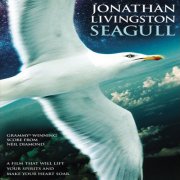IT WAS MORNING, AND THE NEW SUN SPARKLED GOLD across the ripples of a gentle sea.
A mile from shore a fishing boat chummed the water, and the word for Breakfast Flock flashed through the air, till a crowd of a thousand seagulls came to dodge and fight for bits of food. It was another busy day beginning. But way off alone, out by himself beyond boat and shore, Jonathan Livingston Seagull was practising. A hundred feet in the sky he lowered his webbed feet, lifted his beak, and strained to hold a painful hard twisting curve through his wings. The curve meant that he would fly slowly, and now he slowed until the wind was a whisper in his face, until the ocean stood still beneath him. He narrowed his eyes in fierce concentration, held his breath, forced one … single … more … inch … of … curve … Then his feathers ruffled, he stalled and fell. Seagulls, as you know, never falter, never stall. To stall in the air is for them disgrace and it is dishonour. But Jonathan Livingston Seagull, unashamed, stretching his wings again in that trembling hard curve – slowing, slowing, and stalling once more – was no ordinary bird.
Most gulls don’t bother to learn more than the simplest facts of flight — how to get from shore to food and back again. For most gulls, it is not flying that matters, but eating. For this gull, though, it was not eating that mattered, but flight. More than anything else, Jonathan Livingston Seagull loved to fly. This kind of thinking, he found, is not the way to make one’s self popular with other birds. Even his parents were dismayed as Jonathan spent whole days alone, making hundreds of low-level glides, experimenting. He didn’t know why, for instance, but when he flew at altitudes less than half his wingspan above the water, he could stay in the air longer, with less effort. His glides ended not with the usual feet-down splash into the sea, but with a long flat wake as he touched the surface with his feet tightly streamlined against his body. When he began sliding in to feet-up landings on the beach, then pacing the length of his slide in the sand, his parents were very much dismayed indeed. “Why, Jon, why?” his mother asked. “Why is it so hard to be like the rest of the flock, Jon? Why can’t you leave low flying to the pelicans, the albatross? Why don’t you eat? Jon, you’re bone and feathers!” “I don’t mind being bone and feathers, Mum. I just want to know what I can do in the air and what I can’t, that’s all. I just want to know.” “See here, Jonathan,” said his father, not unkindly.
“Winter isn’t far away. Boats will be few, and the surface fish will be swimming deep. If you must study, then study food, and how to get it. This flying business is all very well, but you can’t eat a glide, you know. Don’t you forget that the reason you fly is to eat.” Jonathan nodded obediently. For the next few days he tried to behave like the other gulls; he really tried, screeching and fighting with the flock around the piers and fishing boats, diving on scraps of fish and bread. But he couldn’t make it work. It’s all so pointless, he thought, deliberately dropping a hard-won anchovy to a hungry old gull chasing him. I could be spending all this time learning to fly. There’s so much to learn! It wasn’t long before Jonathan Gull was off by himself again, far out at sea, hungry, happy, learning. The subject was speed, and in a week’s practice he learned more about speed than the fastest gull alive. From a thousand feet, flapping his wings as hard as he could, he pushed over into a blazing steep dive toward the waves, and learned why seagulls don’t make blazing steep power-dives. In just six seconds he was moving seventy miles per hour, the speed at which one’s wing goes unstable on the upstroke. Time after time it happened. Careful as he was, working at the very peak of his ability, he lost control at high speed.

0 Comments
Leave A Comment